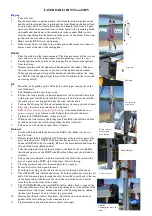
MATERIAL CALIBRATION
mean value). This allows conclusions regarding the quality of the calibration. If
the standard deviation is too high, press ESC to repeat the calibration. Same as
for regular hardness measurements, the standard deviation of the calibration
depends on surface quality, homogeneity and correct probe handling
(perpendicular, without shaking). The standard deviation will be displayed with
one more fractional digits than usual for the hardness scale (Vickers, Brinell
and tensile strength are displayed without any fractional digits, all other
hardness scales with one fractional digit). The standard deviation as
percentage of the mean value will be displayed with two fractional digits.
When the calibration is satisfying, it can be saved. Now you have to decide if
the new calibration shall replace an older one, or if the calibration should be
saved as a new one.
In the first case, you have to select the material that should be replaced.
In the second case, there are three alternatives:
1. The material calibration should be assigned to an existing
section. By these sections, the calibrations can be organized in a
two-level hierarchy, so that you can keep track even if lots of
calibrations are needed. E.g. ferrous materials and aluminum
alloys can be assigned to different sections.
2. If a new section should be created, first the name of the section
and then the name of the calibrated material must be entered.
3. If the material calibration shall not be assigned to any section,
only the name of the calibrated material must be entered.
Now, the new calibration can be selected in
Measuring parameter / Edit /
Material
.
27
Summary of Contents for alphaDUR mini
Page 1: ...alphaDUR mini Manual Version 1 5...
Page 2: ......
















































